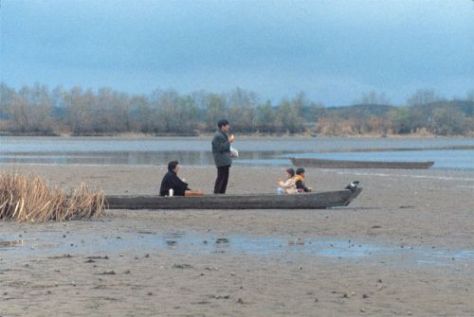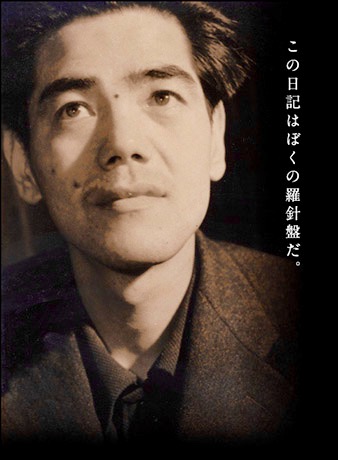
“The Sting of Death” and Other Stories that Kathryn Sparling’s selection of six stories by Shimao Toshio begins with the last nights of WWII, continues to the days after the unconditional surrender, includes the most famous of his “surrealist” stories, and three from the self-lacerating accounts of his wife (Miho) deranged by jealousy, then institutionalized (with a diagnosis of “schizophrenia”), He stayed in the asylum to care for her. Fear that she would kill herself hangs over all three of the (byôsai-mono) sick-with-jealousy wife stories. Unlike his delusions in “Everyday Life in a Dream,” his wife had a basis for her increasingly paranoid jealousy: her husband had had a long-term relationship with another woman than her, the mother of their two children. Her jealousy, nonetheless, far exceeds any rational bounds, and the self-criticism already very salient in the earlier stories crests as he defies the stricken wife.
He met her back on Kakeroma island (in the Ryukus between Okinawa and Kyushu), where he commanded a base of torpedo (kamikaze) boats. She was a teacher and locally elite — and Roman Catholic, the Ryukus having been heavily missionized during the Meiji reign (and highly suspect for subscribing to an “enemy religion” during the Pacific War).
The brief accounts she wrote (included as an appendix in this only Shimao book in English) portray an officer who was very kind and solicitous of the fishing folk. He was much more self-critical, not only of his relations with the locals but his remoteness from the men under his command (often sleeping during the day after spending the night with the local woman based on Miho).
Orders came to man the boats, and Lt. Shimao chose himself to lead the contingent that would go out and try to ram US vessels (only one of the four was put on full readiness). The order did not come. Instead, the Emperor commanded that soldiers and sailors stop dying in his name (i.e., surrendered). Some of the men on the base wanted to go out to be killed, but their commander insisted that they follow the orders issued directly by the Emperor. He also went to the village to read the text of the imperial broadcast, since there were no radios there.
The shame of survival (shinisokonau—failing to die (for the Emperor)) persisted after Shimao’s return to Honshu. “Everyday Life in a Dream” is pretty self-lacerating, beginning with unease that having written about his war experience (failure), he had nothing about which to write. He was arranging participant observation with a gang, but was distracted by a former classmate who had developed leprosy, etc.

The first of the “sick wife” stories, “The Sting of Death,” describes breaking up with his long-term mistress after his wife learns (from his diaries) of his adultery and desperately concerned that she will commit suicide. (I don’t understand the relevance of the title, which derives from First Corinthians 15:55 “O Death, where is they sting? Grave, where is thy victory?”—a couplet defying rather than venerating death in the Japanese manner, celebrating the grace of “victory through our Lord Jesus Christ.” Granted, the “sting” is “sin” in the Pauline epistle)
“Out of the Depths” and “The Heart that Slips Away” are clinical descriptions of the guilty husband and the crazy wife. He converted to his wife’s Catholicism in 1956 and the quest for martyrdom for his sin (adultery) strikes me as based on guilt rather than shame (i.e., Christian rather than traditionally Japanese).
Prefiguring Oe Kenzaburo, Shimao relentlessly reworked the materials about his sin and penitence, including a novel also entitled The Sting of Death. Apparently, the Japanese reading public was fascinated with these self-lacerating accounts. I prefer the life of absurdity as the leader of a group of men waiting to die in torpedo boats who was reprieved (like Dostoevsky’s execution) and then had to cope with being in command of a unit of a navy that had been abolished, i.e., the first two stories, “The Farthest Edge of the Islands” (before surrender) and “This Time That Summer” (after it) and Miho’s alternate (local/native) perspective (in which he was more or less deified, as he would later deify her, albeit for her suffering rather than for his compassion). (I wish that Sparling had included Shimao’s most famous (in Japan) later and seemingly even more self-lacerating version of his end-of-war experience, “When We Never Left Port.” In his later years Shimao was a curator of the Amami Ôshima Museum wrote travel articles and articles about traditional Okinawan culture rather than more fiction.)
Sparling has rendered Shimao’s knotty style (hyper-long sentences, vague anaphora) into quite readable English. The obsessive self-criticism and self-abnegation comes through very clearly. I think only the first two stories have much appeal for American readers, though I realize there are Anglophone admirers of Dostoevsky (and Oe). As Sparling wrote: “There is no escapism in Shimao’s fiction. Even the dreams and the fantasy are intensified experiences of individual reality. These stories are painful to read; there is a[anacut1] masochism about them.”
Sparling analyzes the stories, particularly “Everyday Life in a Dream” (11 pages of discussion for a story that runs 13 pages), at length, as well as discussing stylistic attributes that defied translation.
(After moving back to the Ryukus, Miho functioned, becoming a feminist writer herself and living another twenty years after Toshio’s death. She and their daughter talk in one of Sokurov’s “Oriental Elegies,” “Dolce” (2000).)
©2016, Stephen O. Murray
For an overview of Shimao’s writing and three of his contemporaries (the “third generation”) see Vann C. Gessel’s Sting of Death.
“The Sting of Death” and Other Stories that Kathryn Sparling’s selection of six stories by Shimao Toshio begins with the last nights of WWII, continues to the days after the unconditional surrender, includes the most famous of his “surrealist” stories, and three from the self-lacerating accounts of his wife (Miho) deranged by jealousy, then institutionalized (with a diagnosis of “schizophrenia”), He stayed in the asylum to care for her. Fear that she would kill herself hangs over all three of the (byôsai-mono)-with-jealousy wife stories. Unlike his delusions in “Everyday Life in a Dream,” his wife had a basis for her increasingly paranoid jealousy: her husband had had a long-term relationship with another woman than her, the mother of their two children. Her jealousy, nonetheless, far exceeds any rational bounds, and the self-criticism already very salient in the earlier stories crests as he defies the stricken wife.
He met her back on Kakeroma island (in the Ryukus between Okinawa and Kyushu), where he commanded a base of torpedo (kamikaze) boats. She was a teacher and locally elite — and Roman Catholic, the Ryukus having been heavily missionized during the Meiji reign (and highly suspect for subscribing to an “enemy religion” during the Pacific War).
The brief accounts she wrote (included as an appendix in this only Shimao book in English) portray an officer who was very kind and solicitous of the fishing folk. He was much more self-critical, not only of his relations with the locals but his remoteness from the men under his command (often sleeping during the day after spending the night with the local woman based on Miho).
Orders came to man the boats, and Lt. Shimao chose himself to lead the contingent that would go out and try to ram US vessels (only one of the four was put on full readiness). The order did not come. Instead, the Emperor commanded that soldiers and sailors stop dying in his name (i.e., surrendered). Some of the men on the base wanted to go out to be killed, but their commander insisted that they follow the orders issued directly by the Emperor. He also went to the village to read the text of the imperial broadcast, since there were no radios there.
The shame of survival (shinisokonau—failing to die (for the Emperor)) persisted after Shimao’s return to Honshu. “Everyday Life in a Dream” is pretty self-lacerating, beginning with unease that having written about his war experience (failure), he had nothing about which to write. He was arranging participant observation with a gang, but was distracted by a former classmate who had developed leprosy, etc.
The first of the “sick wife” stories, “The Sting of Death,” describes breaking up with his long-term mistress after his wife learns (from his diaries) of his adultery and desperately concerned that she will commit suicide. (I don’t understand the relevance of the title, which derives from Frist Corinthians 15:55 “O Death, where is they sting? Grave, where is thy victory?”—a couplet defying rather than venerating death in the Japanese manner, celebrating the grace of “victory through our Lord Jesus Christ.” Granted, the “sting” is “sin” in the Pauline epistle)
“Out of the Depths” and “The Heart that Slips Away” are clinical descriptions of the guilty husband and the crazy wife. He converted to his wife’s Catholicism in 1956 and the quest for martyrdom for his sin (adultery) strikes me as based on guilt rather than shame (i.e., Christian rather than traditionally Japanese).
Prefiguring Oe Kenzaburo, Shimao relentlessly reworked the materials about his sin and penitence, including a novel also entitled The Sting of Death. Apparently, the Japanese reading public was fascinated with these self-lacerating accounts. I prefer the life of absurdity as the leader of a group of men waiting to die in torpedo boats who was reprieved (like Dostoevsky’s execution) and then had to cope with being in command of a unit of a navy that had been abolished, i.e., the first two stories, “The Farthest Edge of the Islands” (before surrender) and “This Time That Summer” (after it) and Miho’s alternate (local/native) perspective (in which he was more or less deified, as he would later deify her, albeit for her suffering rather than for his compassion). (I wish that Sparling had included Shimao’s most famous (in Japan) later and seemingly even more self-lacerating version of his end-of-war experience, “When We Never Left Port.” In his later years Shimao was a curator of the Amami Ôshima Museum wrote travel articles and articles about traditional Okinawan culture rather than more fiction.)
Sparling has rendered Shimao’s knotty style (hyper-long sentences, vaguae anaphora) into quite readable English. The obsessive self-criticism and self-abnegation comes through very clearly. I think only the first two stories have much appeal for American readers, though I realize there are Anglophone admirers of Dostoevsky (and Oe). As Sparling wrote: “There is no escapism I Shimao’s fiction. Even the dreams and the fantasy are intensified experiences of individual reality. These stories are painful to read; there is a[anacut1] masochism about them.”
Sparling analyzes the stories, particularly “Everyday Life in a Dream” (11 pages of discussion for a story that runs 13 pages), at length, as well as discussing stylistic attributes that defied translation.
(After moving back to the Ryukus, Miho functioned, becoming a feminist writer herself and living another twenty years after Toshio’s death. She and their daughter talk in one of Sokurov’s “Oriental Elegies,” “Dolce” (2000).)
©2016, Stephen O. Murray